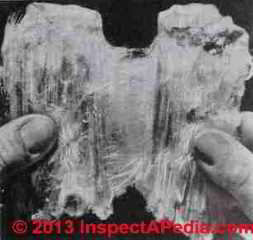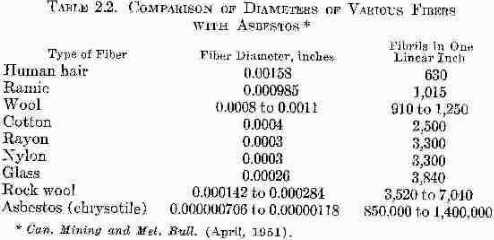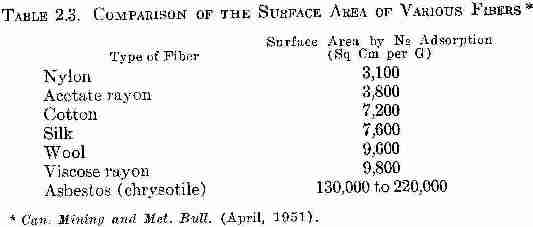 Properties of Asbestos Fibers
Properties of Asbestos Fibers
Asbestos fiber size, diameter, dimensions, surface areas, unit-cell stacking
- POST a QUESTION or COMMENT about asbestos definition, chemical, mechanical, composition, iron content, thermal & other properties
The properties of asbestos fibers such as dimensions, thickness, strength, and related features are discussed in this article.
The ultra-fine thickness of individual asbestos fibers affect its properties, utility, and hazardous nature as explained here.
This article series describes the physical properties of asbestos including its mechanical, chemical, electrical and related properties both in pure asbestos form and when asbestos is mixed with other materials like cement or rubber. As the author points out, while this is a lenghty article, there is far more detailed information about asbestos properties, chemistry, etc.
InspectAPedia tolerates no conflicts of interest. We have no relationship with advertisers, products, or services discussed at this website.
- Daniel Friedman, Publisher/Editor/Author - See WHO ARE WE?
Properties of Asbestos Fibers
 Figure 2.2. View showing parallel fiber structure of asbestos vein, (Courtesy Johns-Manville-Corp.) [Click to enlarge any image]
Figure 2.2. View showing parallel fiber structure of asbestos vein, (Courtesy Johns-Manville-Corp.) [Click to enlarge any image]
Asbestos is generally as dense as the rock in which it occurs but it forms masses of fibers. Specific gravity of the fibers range from 2.5 for chrysotile to 3.3 for the other types.
The fibrous structure of asbestos is as important to its industrial value as its mineral nature. Asbestos can be subdivided into fibers so fine that only the electron microscope will reveal them. The finest fibers are found in chrysotile. Its basic single fiber is a smooth cylinder approximately A in diameter (0.00000071 in.) .
In comparison, a human hair might have a diameter of 0.00158 in. Because of the fine structure of the asbestos, approximately 850,000 1,400,000 fibrils are found in a linear inch of chrysotile ; however, only 630 human hairs can packed into a linear inch.
Table 2.2 below includes information comparing chrysotile asbestos fibers with other common fibers.
[You will observe that asbestos fibers are among the smallest diameter materials known - Ed.]
TABLE 2.2 COMPARISON OF DIAMETERS OF VARIOUS FIBERS WITH ASBESTOS *
* Can. Mining and Met. Bull. (April, 1951).
Asbestos fibers have an extremely large surface area value which is a very important property.
TABLE 2.3. COMPARISON OF THE SURFACE AREA OF VARIOUS Asbestos Fibers *
Surface Area by N2 Adsorption
Type of Fiber
* Can Mining and Met. Bull. (April, 1951) .
The surface area determination of chrysotile depends upon the type of measuring apparatus used. For example, if measurement of the degree of the opening of the fiber bundles is desired, then an air permeability method is quite satisfactory. However, if it is -desired to measure all the available pore space between the fibers, it is necessary to resort to a method employing gas absorption techniques.
The specific surface areas reported by nitrogen absorption show an extreme range of values which is caused by the method of opening the fiber bundles. These values range from 4 to 12 m2/g when carefully opened by hand, or from 30 to 50 m2/g when special mechanical equipment and chemical dispersing agents are used.
Observations made with the electron microscope suggest that fibers of chrysotile may be hollow. The fiber of hornblende types is rather thicker and more solid than chrysotile, consequently it is also less pliable and ductile. The subject of structure of fibers has been of considerable controversy by different basic investigators.
Low angle x-ray scattering techniques have shown that chrysotile fibrils are hexagonally close packed and parallel to each other, having crosssectional diameters varying from 180A to 300A (1 Angstrom unit equals .0000001 mm) while the amphibole fibers are many times larger in cross section.
With regard to physical characteristics of fibers, one of the investigators, Dr. F. L. Pundsack, states: "Although the empirical composition of chrysotile is 3MgO2SiO2.2H20, the true unit cell composition is best represented as Mg12(OH)16S8O20.
This cell has dimensions of a = 5.3A, b = 9.2A and c = 14.6A where the "a" direction is the fiber axis. The calculated density of this unit is 2.56 g/cc, a value in close agreement with experimentally determined density values for chrysotile asbestos.
The exact manner in which the unit cells of asbestos are stacked together to build up a single fiber of chrysotile is not known, but from various lines of experimental evidence it can be estimated that stacking in the "b" direction probably does not exceed a width of about 1,000A.
Stacking in the "c" direction probably is limited to a thickness of not more than 200A, whereas stacking in the "a" direction may extend to a length of many millions of Angstrom units. Because of the nature of the x-ray diffraction pattern of chrysotile it is generally accepted that a single fiber of chrysotile does not exist as a flat lathlike structure, but instead the fiber must be distorted in some way.
Efforts to account for this distortion have ranged from depicting the single fiber as a slightly curved lath all the way to viewing it as a completely curved structure which forms a hollow tube. Recent evideice seems to mitigate against a simple hollow tube structure, but as yet no com- pletely satisfactory structure has been evolved."
...
Continue reading at ASBESTOS IRON CONTENT or select a topic from the closely-related articles below, or see the complete ARTICLE INDEX.
Suggested citation for this web page
ASBESTOS FIBER PROPERTIES at InspectApedia.com - online encyclopedia of building & environmental inspection, testing, diagnosis, repair, & problem prevention advice.
Or see this
INDEX to RELATED ARTICLES: ARTICLE INDEX to ASBESTOS HAZARDS
Or use the SEARCH BOX found below to Ask a Question or Search InspectApedia
Ask a Question or Search InspectApedia
Try the search box just below, or if you prefer, post a question or comment in the Comments box below and we will respond promptly.
Search the InspectApedia website
Note: appearance of your Comment below may be delayed: if your comment contains an image, photograph, web link, or text that looks to the software as if it might be a web link, your posting will appear after it has been approved by a moderator. Apologies for the delay.
Only one image can be added per comment but you can post as many comments, and therefore images, as you like.
You will not receive a notification when a response to your question has been posted.
Please bookmark this page to make it easy for you to check back for our response.
IF above you see "Comment Form is loading comments..." then COMMENT BOX - countable.ca / bawkbox.com IS NOT WORKING.
In any case you are welcome to send an email directly to us at InspectApedia.com at editor@inspectApedia.com
We'll reply to you directly. Please help us help you by noting, in your email, the URL of the InspectApedia page where you wanted to comment.
Citations & References
In addition to any citations in the article above, a full list is available on request.
- [1] ASBESTOS HISTORY & PROPERTIES [Book online] D.V. Roasato, engineering consultant, Newton MA, Reinhold Publishing Co., NY, 1959, Library of Congress Catalog No. 59-12535. We are in process of re-publishing this interesting text. Excerpts & adaptations are found in InspectApedia.com articles on asbestos history, production & visual identification in and on buildings.
- [2] "Asbestos in Plastic Compositions", A.B. Cummins, Modern Plastics [un-dated, pre 1952]
- [3] "Asbestos in Your Home," Spokane County Air Pollution Control Authority, Spokane WA 509-477-4727 www.scapa.org provides a one-page image, a .pdf file drawing of a house warning of some possible sources of asbestos in the home. The sources are not ranked according to actual risk of releasing hazardous levels of airborne asbestos fibers and the list is useful but incomplete.
- [4] The US EPA provides a sample list of asbestos containing products epa.gov/earth1r6/6pd/asbestos/asbmatl.htm
- [5] "Characterization of asbestos exposure among automotive mechanics servicing and handling asbestos-containing materials", Gary Scott Dotson, University of South Florida, 1 June 2006, web search 3/9/2012 original source: scholarcommons.usf.edu/cgi/viewcontent.cgi?article=3505&context=etd [copy on file as /hazmat/Automotive_Asbestos_Exposure.pdf ].
- [6] Asbestos Identification and Testing References
- Asbestos Identification, Walter C.McCrone, McCrone Research Institute, Chicago, IL.1987 ISBN 0-904962-11-3. Dr. McCrone literally "wrote the book" on asbestos identification procedures which formed the basis for current work by asbestos identification laboratories.
- Stanton, .F., et al., National Bureau of Standards Special Publication 506: 143-151
- Pott, F., Staub-Reinhalf Luft 38, 486-490 (1978) cited by McCrone
- [6] ASBESTOS IN YOUR HOME U.S. EPA, Exposure Evaluation Division, Office of Toxic Substances, Office of Pesticides and Toxic Substances, U.S. Environmental Protection Agency, Washington,D.C. 20460
- [7] Asbestos products and their history and use in various building materials such as asphalt and vinyl flooring includes discussion which draws on ASBESTOS, ITS INDUSTRIAL APPLICATIONS, ROSATO 1959, D.V. Rosato, engineering consultant, Newton, MA, Reinhold Publishing, 1959 Library of Congress Catalog Card No.: 59-12535 (out of print, text and images available at InspectAPedia.com).
- [8] "Handling Asbestos-Containing roofing material - an update", Carl Good, NRCA Associate Executive Director, Professional Roofing, February 1992, p. 38-43
- [9] EPA Guidance for Controlling Asbestos-Containing Materials in buildings, NIAST, National Institute on Abatement Sciences & Technology, [republishing EPA public documents] 1985 ed., Exposure Evaluation Division, Office of Toxic Substances, Office of Pesticides and Toxic Substances, U.S. Environmental Protection Agency, Washington,D.C. 20460
- EPA ASBESTOS MATERIALS BAN: CLARIFICATION 1999
- Basic Information about Asbestos, US EPA, web search 08/17/2010, original source: http://www.epa.gov/asbestos/pubs/help.html
- "Handling Asbestos-Containing roofing material - an update", Carl Good, NRCA Associate Executive Director, Professional Roofing, February 1992, p. 38-43
- EPA Guidance for Controlling Asbestos-Containing Materials in buildings, NIAST, National Institute on Abatement Sciences & Technology, [republishing EPA public documents] 1985 ed., Exposure Evaluation Division, Office of Toxic Substances, Office of Pesticides and Toxic Substances, U.S. Environmental Protection Agency, Washington,D.C. 20460
- EPA, ASBESTOS IN YOUR HOME [PDF] - U.S. EPA, Exposure Evaluation Division, Office of Toxic Substances, Office of Pesticides and Toxic Substances, U.S. Environmental Protection Agency, Washington,D.C. 20460
- Vermiculite:
Protect Your Family from Asbestos-Contaminated Vermiculite Insulation, U.S. EPA , web search 08/17/2010, original source: http://www.epa.gov/asbestos/pubs/verm.html
Web search 01/20/2011, original source: http://epa.gov/asbestos/pubs/verm_questions.html - Proteja su familia del aislante de vermiculita contaminado con asbesto, U.S. EPA HOJA INFORMATIVA - Proteja a su familia del aislante de vermiculita contaminado con asbestos, web search 08/17/2010, original source http://www.epa.gov/asbestos/pubs/verm-ques-sp.pdf
- [copy on file as /hazmat/Vermiculite_US_EPA.pdf/ Current Best Practices for Vermiculite Attic Insulation - May 2003, U.S. EPA
- [copy on file as] /hazmat/Vermiculite_Health_Canada.pdf] Vermiculite Insulation Containing Amphibole Asbestos - September 2009, Health Canada
- Managing Asbestos in Place, How to Develop and Maintain a Building Asbestos Operations and Maintenance (O&M) Program, U.S. EPA, web search 01/20/2011, original source: http://www.epa.gov/asbestos/pubs/management_in_place.html
- Asbestos Strategies, Lessons Learned about Management and Use of Asbestos: Report of Findings and Recommendations on the Use and Management of Asbestos, 16 May 2003, US EPA, web search 01/20/2011, original source: http://www.epa.gov/asbestos/pubs/asbstrategiesrptgetf.pdf
prepared by the: Global Environment & Technology Foundation, 7010 Little River Turnpike, Suite. 460, Annandale VA 20003 - Other US EPA Publications on asbestos: web search 01/20/2011, see http://www.epa.gov/asbestos/pubs/pubs.html
- In addition to citations & references found in this article, see the research citations given at the end of the related articles found at our suggested
CONTINUE READING or RECOMMENDED ARTICLES.
- Carson, Dunlop & Associates Ltd., 120 Carlton Street Suite 407, Toronto ON M5A 4K2. Tel: (416) 964-9415 1-800-268-7070 Email: info@carsondunlop.com. Alan Carson is a past president of ASHI, the American Society of Home Inspectors.
Thanks to Alan Carson and Bob Dunlop, for permission for InspectAPedia to use text excerpts from The HOME REFERENCE BOOK - the Encyclopedia of Homes and to use illustrations from The ILLUSTRATED HOME .
Carson Dunlop Associates provides extensive home inspection education and report writing material. In gratitude we provide links to tsome Carson Dunlop Associates products and services.



